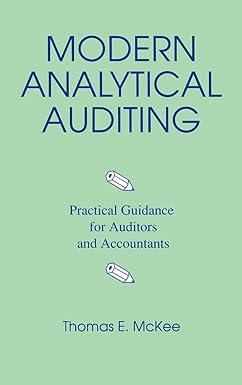Answered step by step
Verified Expert Solution
Question
1 Approved Answer
HI, I ONLY NEED STAGE 2: Questions 1,2, and 3 answered! Thank You! Stage One A history of Humble Pies Humble Pies, Inc. is the
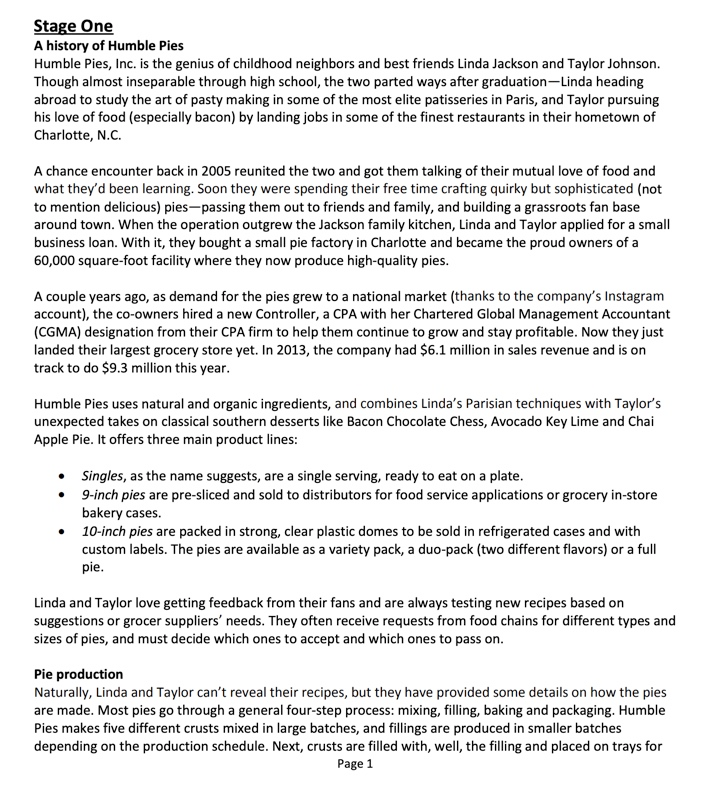
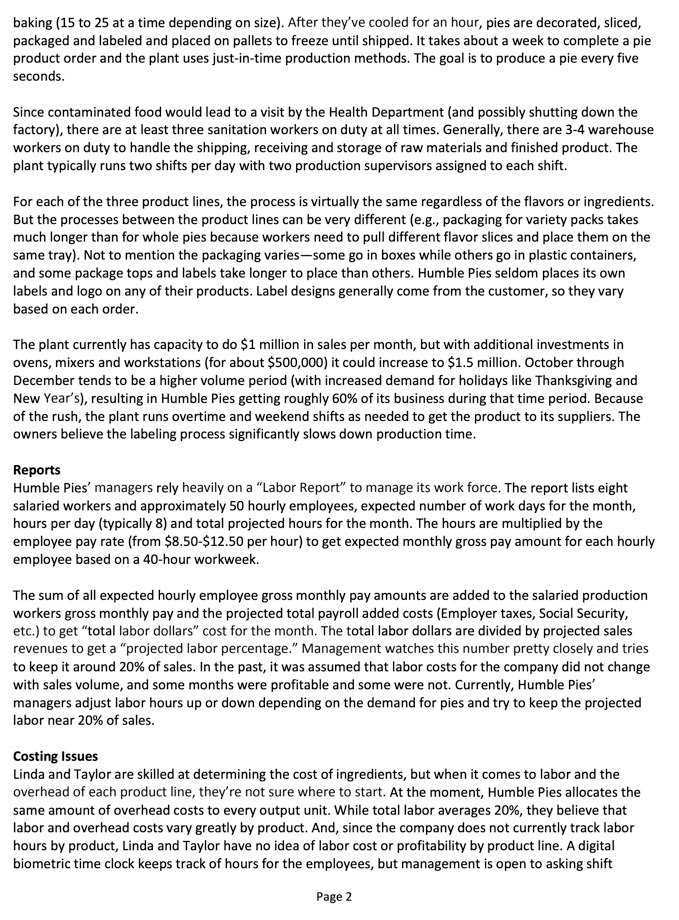
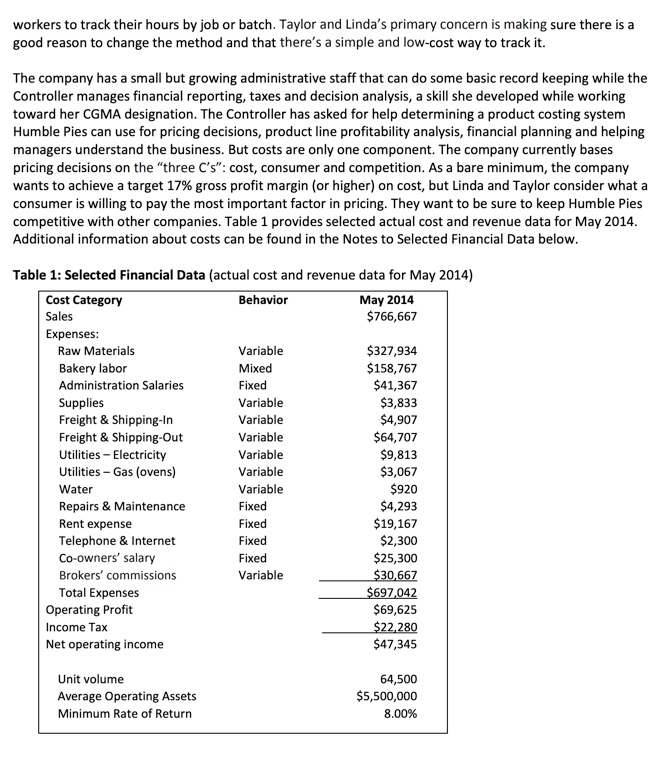
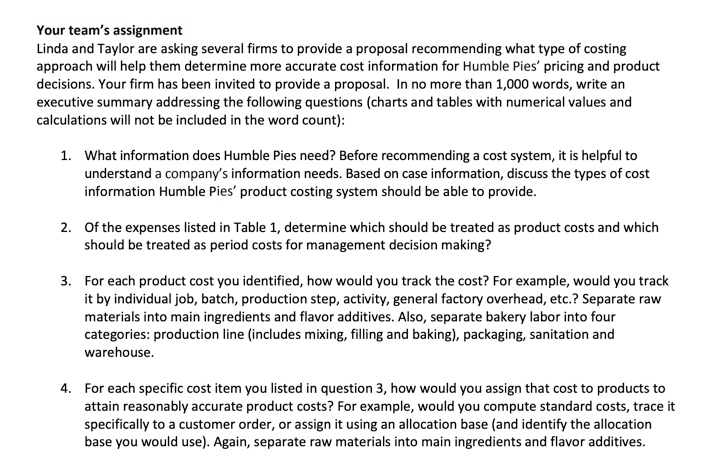
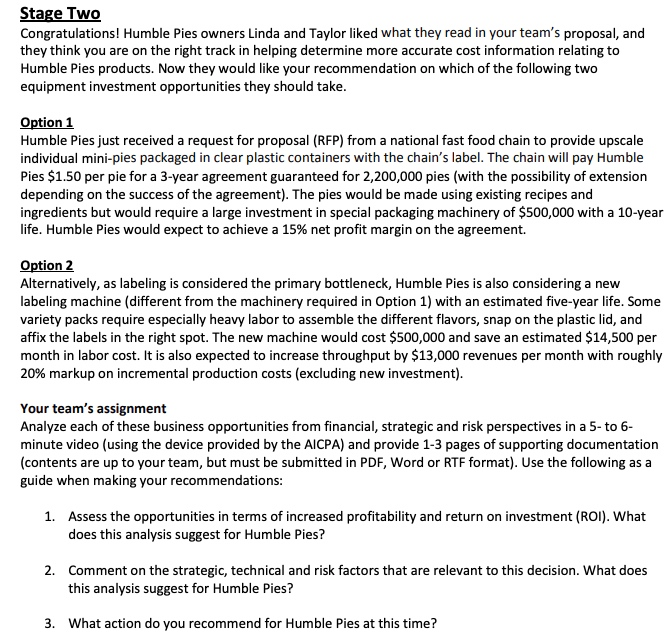
HI, I ONLY NEED STAGE 2: Questions 1,2, and 3 answered! Thank You!
Stage One A history of Humble Pies Humble Pies, Inc. is the genius of childhood neighbors and best friends Linda Jackson and Taylor Johnson. Though almost inseparable through high school, the two parted ways after graduation-Linda heading abroad to study the art of pasty making in some of the most elite patisseries in Paris, and Taylor pursuing his love of food (especially bacon) by landing jobs in some of the finest restaurants in their hometown of Charlotte, N.C. A chance encounter back in 2005 reunited the two and got them talking of their mutual love of food and what they'd been learning. Soon they were spending their free time crafting quirky but sophisticated (not to mention delicious) pies-passing them out to friends and family, and building a grassroots fan base around town. When the operation outgrew the Jackson family kitchen, Linda and Taylor applied for a small business loan. With it, they bought a small pie factory in Charlotte and became the proud owners of a 60,000 square-foot facility where they now produce high-quality pies. A couple years ago, as demand for the pies grew to a national market (thanks to the company's Instagram account), the co-owners hired a new Controller, a CPA with her Chartered Global Management Accountant (CGMA) designation from their CPA firm to help them continue to grow and stay profitable. Now they just landed their largest grocery store yet. In 2013, the company had $6.1 million in sales revenue and is on track to do $9.3 million this year. Humble Pies uses natural and organic ingredients, and combines Linda's Parisian techniques with Taylor's unexpected takes on classical southern desserts like Bacon Chocolate Chess, Avocado Key Lime and Chai Apple Pie. It offers three main product lines: Singles, as the name suggests, are a single serving, ready to eat on a plate. 9-inch pies are pre-sliced and sold to distributors for food service applications or grocery in-store bakery cases. 10-inch pies are packed in strong, clear plastic domes to be sold in refrigerated cases and with custom labels. The pies are available as a variety pack, a duo-pack (two different flavors) or a full pie. Linda and Taylor love getting feedback from their fans and are always testing new recipes based on suggestions or grocer suppliers' needs. They often receive requests from food chains for different types and sizes of pies, and must decide which ones to accept and which ones to pass on. Pie production Naturally, Linda and Taylor can't reveal their recipes, but they have provided some details on how the pies are made. Most pies go through a general four-step process: mixing, filling, baking and packaging. Humble Pies makes five different crusts mixed in large batches, and fillings are produced in smaller batches depending on the production schedule. Next, crusts are filled with, well, the filling and placed on trays for Page 1 baking (15 to 25 at a time depending on size). After they've cooled for an hour, pies are decorated, sliced, packaged and labeled and placed on pallets to freeze until shipped. It takes about a week to complete a pie product order and the plant uses just-in-time production methods. The goal is to produce a pie every five seconds. Since contaminated food would lead to a visit by the Health Department (and possibly shutting down the factory), there are at least three sanitation workers on duty at all times. Generally, there are 3-4 warehouse workers on duty to handle the shipping, receiving and storage of raw materials and finished product. The plant typically runs two shifts per day with two production supervisors assigned to each shift. For each of the three product lines, the process is virtually the same regardless of the flavors or ingredients. But the processes between the product lines can be very different (e.g., packaging for variety packs takes much longer than for whole pies because workers need to pull different flavor slices and place them on the same tray). Not to mention the packaging varies-some go in boxes while others go in plastic containers, and some package tops and labels take longer to place than others. Humble Pies seldom places its own labels and logo on any of their products. Label designs generally come from the customer, so they vary based on each order. The plant currently has capacity to do $1 million in sales per month, but with additional investments in ovens, mixers and workstations (for about $500,000) it could increase to $1.5 million. October through December tends to be a higher volume period (with increased demand for holidays like Thanksgiving and New Year's), resulting in Humble Pies getting roughly 60% of its business during that time period. Because of the rush, the plant runs overtime and weekend shifts as needed to get the product to its suppliers. The owners believe the labeling process significantly slows down production time. Reports Humble Pies' managers rely heavily on a "Labor Report" to manage its work force. The report lists eight salaried workers and approximately 50 hourly employees, expected number of work days for the month, hours per day (typically 8) and total projected hours for the month. The hours are multiplied by the employee pay rate (from $8.50-$12.50 per hour) to get expected monthly gross pay amount for each hourly employee based on a 40-hour workweek. The sum of all expected hourly employee gross monthly pay amounts are added to the salaried production workers gross monthly pay and the projected total payroll added costs (Employer taxes, Social Security, etc.) to get "total labor dollars" cost for the month. The total labor dollars are divided by projected sales revenues to get a "projected labor percentage." Management watches this number pretty closely and tries to keep it around 20% of sales. In the past, it was assumed that labor costs for the company did not change with sales volume, and some months were profitable and some were not. Currently, Humble Pies' managers adjust labor hours up or down depending on the demand for pies and try to keep the projected labor near 20% of sales. Costing Issues Linda and Taylor are skilled at determining the cost of ingredients, but when it comes to labor and the overhead of each product line, they're not sure where to start. At the moment, Humble Pies allocates the same amount of overhead costs to every output unit. While total labor averages 20%, they believe that labor and overhead costs vary greatly by product. And, since the company does not currently track labor hours by product, Linda and Taylor have no idea of labor cost or profitability by product line. A digital biometric time clock keeps track of hours for the employees, but management is open to asking shift Page 2 workers to track their hours by job or batch. Taylor and Linda's primary concern is making sure there is a good reason to change the method and that there's a simple and low-cost way to track it. The company has a small but growing administrative staff that can do some basic record keeping while the Controller manages financial reporting, taxes and decision analysis, a skill she developed while working toward her CGMA designation. The Controller has asked for help determining a product costing system Humble Pies can use for pricing decisions, product line profitability analysis, financial planning and helping managers understand the business. But costs are only one component. The company currently bases pricing decisions on the "three C's": cost, consumer and competition. As a bare minimum, the company wants to achieve a target 17% gross profit margin (or higher) on cost, but Linda and Taylor consider what a consumer is willing to pay the most important factor in pricing. They want to be sure to keep Humble Pies competitive with other companies. Table 1 provides selected actual cost and revenue data for May 2014. Additional information about costs can be found in the Notes to Selected Financial Data below. Table 1: Selected Financial Data (actual cost and revenue data for May 2014) Cost Category Behavior May 2014 Sales $766,667 Expenses: Raw Materials Variable $327,934 Bakery labor Mixed $158,767 Administration Salaries Fixed $41,367 Supplies Variable $3,833 Freight & Shipping-In Variable $4,907 Freight & Shipping-Out Variable $64,707 Utilities - Electricity Variable $9,813 Utilities - Gas (ovens) Variable $3,067 Water Variable $920 Repairs & Maintenance Fixed $4,293 Rent expense Fixed $19,167 Telephone & Internet Fixed $2,300 Co-owners' salary Fixed $25,300 Brokers' commissions Variable $30,667 Total Expenses $697,042 Operating Profit $69,625 Income Tax $22,280 Net operating income $47,345 Unit volume Average Operating Assets Minimum Rate of Return 64,500 $5,500,000 8.00% Your team's assignment Linda and Taylor are asking several firms to provide a proposal recommending what type of costing approach will help them determine more accurate cost information for Humble Pies' pricing and product decisions. Your firm has been invited to provide a proposal. In no more than 1,000 words, write an executive summary addressing the following questions (charts and tables with numerical values and calculations will not be included in the word count): 1. What information does Humble Pies need? Before recommending a cost system, it is helpful to understand a company's information needs. Based on case information, discuss the types of cost information Humble Pies' product costing system should be able to provide. 2. Of the expenses listed in Table 1, determine which should be treated as product costs and which should be treated as period costs for management decision making? 3. For each product cost you identified, how would you track the cost? For example, would you track it by individual job, batch, production step, activity, general factory overhead, etc.? Separate raw materials into main ingredients and flavor additives. Also, separate bakery labor into four categories: production line (includes mixing, filling and baking), packaging, sanitation and warehouse. 4. For each specific cost item you listed in question 3, how would you assign that cost to products to attain reasonably accurate product costs? For example, would you compute standard costs, trace it specifically to a customer order, or assign it using an allocation base (and identify the allocation base you would use). Again, separate raw materials into main ingredients and flavor additives. Stage Two Congratulations! Humble Pies owners Linda and Taylor liked what they read in your team's proposal, and they think you are on the right track in helping determine more accurate cost information relating to Humble Pies products. Now they would like your recommendation on which of the following two equipment investment opportunities they should take. Option 1 Humble Pies just received a request for proposal (RFP) from a national fast food chain to provide upscale individual mini-pies packaged in clear plastic containers with the chain's label. The chain will pay Humble Pies $1.50 per pie for a 3-year agreement guaranteed for 2,200,000 pies (with the possibility of extension depending on the success of the agreement). The pies would be made using existing recipes and ingredients but would require a large investment in special packaging machinery of $500,000 with a 10-year life. Humble Pies would expect to achieve a 15% net profit margin on the agreement. Option 2 Alternatively, as labeling is considered the primary bottleneck, Humble Pies is also considering a new labeling machine (different from the machinery required in Option 1) with an estimated five-year life. Some variety packs require especially heavy labor to assemble the different flavors, snap on the plastic lid, and affix the labels in the right spot. The new machine would cost $500,000 and save an estimated $14,500 per month in labor cost. It is also expected to increase throughput by $13,000 revenues per month with roughly 20% markup on incremental production costs (excluding new investment). Your team's assignment Analyze each of these business opportunities from financial, strategic and risk perspectives in a 5- to 6- minute video (using the device provided by the AICPA) and provide 1-3 pages of supporting documentation (contents are up to your team, but must be submitted in PDF, Word or RTF format). Use the following as a guide when making your recommendations: 1. Assess the opportunities in terms of increased profitability and return on investment (ROI). What does this analysis suggest for Humble Pies? 2. Comment on the strategic, technical and risk factors that are relevant to this decision. What does this analysis suggest for Humble Pies? 3. What action do you recommend for Humble Pies at this time? Stage One A history of Humble Pies Humble Pies, Inc. is the genius of childhood neighbors and best friends Linda Jackson and Taylor Johnson. Though almost inseparable through high school, the two parted ways after graduation-Linda heading abroad to study the art of pasty making in some of the most elite patisseries in Paris, and Taylor pursuing his love of food (especially bacon) by landing jobs in some of the finest restaurants in their hometown of Charlotte, N.C. A chance encounter back in 2005 reunited the two and got them talking of their mutual love of food and what they'd been learning. Soon they were spending their free time crafting quirky but sophisticated (not to mention delicious) pies-passing them out to friends and family, and building a grassroots fan base around town. When the operation outgrew the Jackson family kitchen, Linda and Taylor applied for a small business loan. With it, they bought a small pie factory in Charlotte and became the proud owners of a 60,000 square-foot facility where they now produce high-quality pies. A couple years ago, as demand for the pies grew to a national market (thanks to the company's Instagram account), the co-owners hired a new Controller, a CPA with her Chartered Global Management Accountant (CGMA) designation from their CPA firm to help them continue to grow and stay profitable. Now they just landed their largest grocery store yet. In 2013, the company had $6.1 million in sales revenue and is on track to do $9.3 million this year. Humble Pies uses natural and organic ingredients, and combines Linda's Parisian techniques with Taylor's unexpected takes on classical southern desserts like Bacon Chocolate Chess, Avocado Key Lime and Chai Apple Pie. It offers three main product lines: Singles, as the name suggests, are a single serving, ready to eat on a plate. 9-inch pies are pre-sliced and sold to distributors for food service applications or grocery in-store bakery cases. 10-inch pies are packed in strong, clear plastic domes to be sold in refrigerated cases and with custom labels. The pies are available as a variety pack, a duo-pack (two different flavors) or a full pie. Linda and Taylor love getting feedback from their fans and are always testing new recipes based on suggestions or grocer suppliers' needs. They often receive requests from food chains for different types and sizes of pies, and must decide which ones to accept and which ones to pass on. Pie production Naturally, Linda and Taylor can't reveal their recipes, but they have provided some details on how the pies are made. Most pies go through a general four-step process: mixing, filling, baking and packaging. Humble Pies makes five different crusts mixed in large batches, and fillings are produced in smaller batches depending on the production schedule. Next, crusts are filled with, well, the filling and placed on trays for Page 1 baking (15 to 25 at a time depending on size). After they've cooled for an hour, pies are decorated, sliced, packaged and labeled and placed on pallets to freeze until shipped. It takes about a week to complete a pie product order and the plant uses just-in-time production methods. The goal is to produce a pie every five seconds. Since contaminated food would lead to a visit by the Health Department (and possibly shutting down the factory), there are at least three sanitation workers on duty at all times. Generally, there are 3-4 warehouse workers on duty to handle the shipping, receiving and storage of raw materials and finished product. The plant typically runs two shifts per day with two production supervisors assigned to each shift. For each of the three product lines, the process is virtually the same regardless of the flavors or ingredients. But the processes between the product lines can be very different (e.g., packaging for variety packs takes much longer than for whole pies because workers need to pull different flavor slices and place them on the same tray). Not to mention the packaging varies-some go in boxes while others go in plastic containers, and some package tops and labels take longer to place than others. Humble Pies seldom places its own labels and logo on any of their products. Label designs generally come from the customer, so they vary based on each order. The plant currently has capacity to do $1 million in sales per month, but with additional investments in ovens, mixers and workstations (for about $500,000) it could increase to $1.5 million. October through December tends to be a higher volume period (with increased demand for holidays like Thanksgiving and New Year's), resulting in Humble Pies getting roughly 60% of its business during that time period. Because of the rush, the plant runs overtime and weekend shifts as needed to get the product to its suppliers. The owners believe the labeling process significantly slows down production time. Reports Humble Pies' managers rely heavily on a "Labor Report" to manage its work force. The report lists eight salaried workers and approximately 50 hourly employees, expected number of work days for the month, hours per day (typically 8) and total projected hours for the month. The hours are multiplied by the employee pay rate (from $8.50-$12.50 per hour) to get expected monthly gross pay amount for each hourly employee based on a 40-hour workweek. The sum of all expected hourly employee gross monthly pay amounts are added to the salaried production workers gross monthly pay and the projected total payroll added costs (Employer taxes, Social Security, etc.) to get "total labor dollars" cost for the month. The total labor dollars are divided by projected sales revenues to get a "projected labor percentage." Management watches this number pretty closely and tries to keep it around 20% of sales. In the past, it was assumed that labor costs for the company did not change with sales volume, and some months were profitable and some were not. Currently, Humble Pies' managers adjust labor hours up or down depending on the demand for pies and try to keep the projected labor near 20% of sales. Costing Issues Linda and Taylor are skilled at determining the cost of ingredients, but when it comes to labor and the overhead of each product line, they're not sure where to start. At the moment, Humble Pies allocates the same amount of overhead costs to every output unit. While total labor averages 20%, they believe that labor and overhead costs vary greatly by product. And, since the company does not currently track labor hours by product, Linda and Taylor have no idea of labor cost or profitability by product line. A digital biometric time clock keeps track of hours for the employees, but management is open to asking shift Page 2 workers to track their hours by job or batch. Taylor and Linda's primary concern is making sure there is a good reason to change the method and that there's a simple and low-cost way to track it. The company has a small but growing administrative staff that can do some basic record keeping while the Controller manages financial reporting, taxes and decision analysis, a skill she developed while working toward her CGMA designation. The Controller has asked for help determining a product costing system Humble Pies can use for pricing decisions, product line profitability analysis, financial planning and helping managers understand the business. But costs are only one component. The company currently bases pricing decisions on the "three C's": cost, consumer and competition. As a bare minimum, the company wants to achieve a target 17% gross profit margin (or higher) on cost, but Linda and Taylor consider what a consumer is willing to pay the most important factor in pricing. They want to be sure to keep Humble Pies competitive with other companies. Table 1 provides selected actual cost and revenue data for May 2014. Additional information about costs can be found in the Notes to Selected Financial Data below. Table 1: Selected Financial Data (actual cost and revenue data for May 2014) Cost Category Behavior May 2014 Sales $766,667 Expenses: Raw Materials Variable $327,934 Bakery labor Mixed $158,767 Administration Salaries Fixed $41,367 Supplies Variable $3,833 Freight & Shipping-In Variable $4,907 Freight & Shipping-Out Variable $64,707 Utilities - Electricity Variable $9,813 Utilities - Gas (ovens) Variable $3,067 Water Variable $920 Repairs & Maintenance Fixed $4,293 Rent expense Fixed $19,167 Telephone & Internet Fixed $2,300 Co-owners' salary Fixed $25,300 Brokers' commissions Variable $30,667 Total Expenses $697,042 Operating Profit $69,625 Income Tax $22,280 Net operating income $47,345 Unit volume Average Operating Assets Minimum Rate of Return 64,500 $5,500,000 8.00% Your team's assignment Linda and Taylor are asking several firms to provide a proposal recommending what type of costing approach will help them determine more accurate cost information for Humble Pies' pricing and product decisions. Your firm has been invited to provide a proposal. In no more than 1,000 words, write an executive summary addressing the following questions (charts and tables with numerical values and calculations will not be included in the word count): 1. What information does Humble Pies need? Before recommending a cost system, it is helpful to understand a company's information needs. Based on case information, discuss the types of cost information Humble Pies' product costing system should be able to provide. 2. Of the expenses listed in Table 1, determine which should be treated as product costs and which should be treated as period costs for management decision making? 3. For each product cost you identified, how would you track the cost? For example, would you track it by individual job, batch, production step, activity, general factory overhead, etc.? Separate raw materials into main ingredients and flavor additives. Also, separate bakery labor into four categories: production line (includes mixing, filling and baking), packaging, sanitation and warehouse. 4. For each specific cost item you listed in question 3, how would you assign that cost to products to attain reasonably accurate product costs? For example, would you compute standard costs, trace it specifically to a customer order, or assign it using an allocation base (and identify the allocation base you would use). Again, separate raw materials into main ingredients and flavor additives. Stage Two Congratulations! Humble Pies owners Linda and Taylor liked what they read in your team's proposal, and they think you are on the right track in helping determine more accurate cost information relating to Humble Pies products. Now they would like your recommendation on which of the following two equipment investment opportunities they should take. Option 1 Humble Pies just received a request for proposal (RFP) from a national fast food chain to provide upscale individual mini-pies packaged in clear plastic containers with the chain's label. The chain will pay Humble Pies $1.50 per pie for a 3-year agreement guaranteed for 2,200,000 pies (with the possibility of extension depending on the success of the agreement). The pies would be made using existing recipes and ingredients but would require a large investment in special packaging machinery of $500,000 with a 10-year life. Humble Pies would expect to achieve a 15% net profit margin on the agreement. Option 2 Alternatively, as labeling is considered the primary bottleneck, Humble Pies is also considering a new labeling machine (different from the machinery required in Option 1) with an estimated five-year life. Some variety packs require especially heavy labor to assemble the different flavors, snap on the plastic lid, and affix the labels in the right spot. The new machine would cost $500,000 and save an estimated $14,500 per month in labor cost. It is also expected to increase throughput by $13,000 revenues per month with roughly 20% markup on incremental production costs (excluding new investment). Your team's assignment Analyze each of these business opportunities from financial, strategic and risk perspectives in a 5- to 6- minute video (using the device provided by the AICPA) and provide 1-3 pages of supporting documentation (contents are up to your team, but must be submitted in PDF, Word or RTF format). Use the following as a guide when making your recommendations: 1. Assess the opportunities in terms of increased profitability and return on investment (ROI). What does this analysis suggest for Humble Pies? 2. Comment on the strategic, technical and risk factors that are relevant to this decision. What does this analysis suggest for Humble Pies? 3. What action do you recommend for Humble Pies at this timeStep by Step Solution
There are 3 Steps involved in it
Step: 1

Get Instant Access to Expert-Tailored Solutions
See step-by-step solutions with expert insights and AI powered tools for academic success
Step: 2

Step: 3

Ace Your Homework with AI
Get the answers you need in no time with our AI-driven, step-by-step assistance
Get Started


